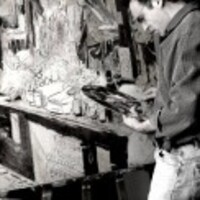D.L Estrabaut
Didier L.Estrabaut’s work of art can be described as eclectic. Far from an obsessive quest, it stems from a need to tame desires and spurs-of-the-moment to satisfy a never-ending curiosity. As the artist himself puts it: “To me, technique is not a purpose but a plain narrative tool”.
This could be considered as the essence of an artist in constant research. His work however derives more from a concern to adapt the technique to the meaning, even if this jeopardises the audience’s understanding. Nevertheless, this serial and thematic work conveys the necessary consistency and continuity: “I quite enjoy the idea of not being bound to “my own self” from one day to the other, which may lead to the other being eventually more genuine! I’m claiming the right for an almost continuous “aesthetical switching” so long as the pleasure of discovery gets every time strengthened”.
It is thus more a desire to be part of a continuity and the legacy of former masters, than craving for revolutionizing. The artist reveals a closer relationship to the seventeenth century Dutch painting, to the great British portrait tradition, to the Romantics, or even to the American realist tradition than to Pop iconoclasm
Since 2009, a series of « commonplace » bar scenes with sometimes Fauvist or realist rings feed his production. His “theatre” cafés link loneliness and roving together.
Space is deliberately sealed, without any horizon. It’s an everyday life stalk in its most banal and mediocre aspects, to reveal its unexpected beauty through a sometimes plain and sometimes exuberant aesthetics. The unspoken, the immobility and silence are full participants. This gives way to a familiar dramatic, which gets cleverly staged thanks to a demanding design and an accurate stage designer’s eye.
After having spent 10 years in Panama, Didier L.Estrabaut came back to his hometown in 2006 and started to work on the surrounding landscapes with a true naturalist eye. This gave life to a series of pine trees inspired by Francis Ponge's prose ("The Pine forest") that resembled a genuine floral cathedral bathed in a sometimes vibrant and deep, sometimes pale and gauzy light. He then painted in the same fashion roads that seemed to stab the landscape, creating endless straight asphalt trenches in the heart of the forest.
Then, presumably eager to measure himself up to his most famous predecessors, he has been painting a series of constantly changing water lilies, where space is structured by successive shots, alternating impasto and fluid strokes in a constant search for balance between strength and flexibility, immutability and swaying in a clear reference to Eastern art and mindset. This balance may also be perceived as a search for opposition and complementarities such as can be found between the dark and cold Yin, i.e. the water symbol of femininity, and the Yang its completing opposite, which is bright, hard, fast, and always in action and movement like the fire, the symbol of masculinity, giving way to a bipolar and indivisible nature.

